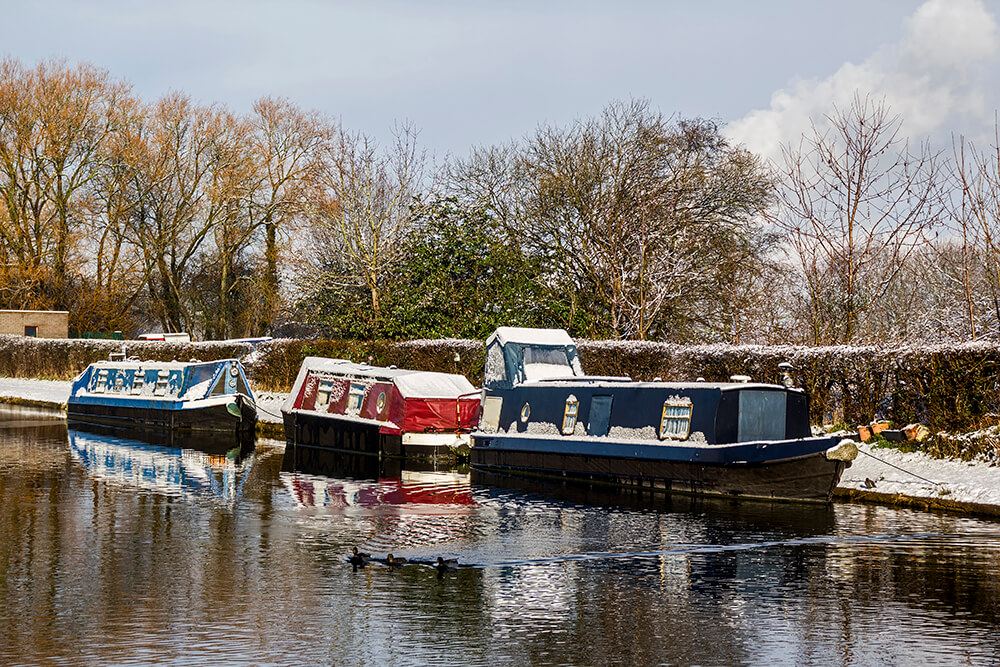
While the thought of winterising your narrowboat may be some way off, our seasons are becoming more extreme, which means in addition to wetter summers, the winters are likely to get colder.
There is a consensus that climate change will bring warmer winters, however according to a BBC report (Feb 25 – could the UK actually get colder with global warming?), some scientists predict the UK and north-west Europe could buck the global warming trend and face plunging temperatures and freezing winters.
This month, River Canal Rescue advises how to winterise your narrowboat and avoid costly repair bills.
Cooling systems
Any ‘closed loop’ cooling system needs anti-freeze added and replaced (per manufacturer’s guidelines). This minimises the risk of splits or fractures due to freezing water and engine corrosion, plus improves the engine’s cooling efficiency.
If it’s a raw water (drawn from the river) cooling system, drain down by briefly running the engine when out of the water to empty the system. If afloat, ‘shut off’ the inlet valve (seacock) and drain as much water from the system as possible.
Where no drain plug is available, disconnect a hose, drain the water from the system and leave disconnected. Although this will not empty the system completely, it will allow for expansion should the water freeze, reducing the risk of ruptured pipes. Insulate any accessible tight bends, as this is where fluid collects, even after draining. Once you start cruising again, reconnect any pipes, refill the system and open the seacock.
If the engine’s winterised or seacock’s closed, clearly mark the engine and its controls; it should prevent accidental operation.
General checks
Check lockers, cockpit and other areas to ensure all drain holes and plugs are clear of debris, leaves, dirt etc. These areas block easily and in heavy or prolonged rain, can cause a vessel to take on water causing corrosion where the water’s left sitting or even worse, sinking.
Test the bilge pump and if possible, invest in an automatic one – it’s more reliable than a manual. An automatic bilge pump immediately responds to water ingress with the float switch dictating when it should pump. Should a leak develop from cooling system, hull or other source (or there’s a build-up of rain water), this will keep your vessel safe.
Water in a boat will cause it to be lower in the water, placing outlets such as those for a shower, sink or air vent, nearer to the water level (leading to catastrophic results!).
Check battery charge levels before leaving the boat and when you return, or before a long journey. Heavy rainfall, leaking stern glands and weed hatch issues can result in water ingress that quickly fills the boat, causing it to sink. If batteries go flat at a critical point it can be devastating.
Grease the stern tube before leaving the boat, this will prevent water ingress. Although most stern glands leak once the propeller turns, the grease acts like a seal whilst not in use.
Ensure boat mooring pins and ropes are secure, yet slack enough to deal with the normal rise or fall of water levels. Where possible attach a long rope to a tree or higher ground, so that if flooding occurs, or the boat becomes loose in high winds, the additional rope provides a much-needed safety line. In extreme weather or prolonged rainfall, visit the boat regularly to adjust mooring ropes and check bilge pumps and batteries are coping with the situation.
Run the engine for an hour every time you visit as this pushes oil around the engine and prevents rusting, plus it tops up the battery if left running long enough (beware of doing this if you’ve drained the cooling system!).
Spray terminals with a silicone-free lubricant, grease all available grease points on the engine and drive, plus electrical connectors, and lubricate linkages and gear/throttle slides; this prevents rusting/corrosion and gives these components a longer life.
Generators
If not in use, store in a gas-tight locker – the same regulations as Liquid Petroleum Gas (LPG) apply.
Water and heating
Freezing temperatures can cause split or fractured pipes which, if left over a gradual period, can lead to complete or partial flooding.
Drain down the water system (including drinking water and cistern) and leave taps in the open position. Most water heaters have a screw plug at their base and can accommodate an old-fashioned cycle pump which makes the emptying of water that much quicker.
Taps should be left open so if any water is left in the system and it freezes, the pressure on the pipes will be less due to air coming out of the taps.
An unnoticed pipe split and flooding will almost certainly lead to sinking which may not be covered by insurers (not all cover frost damage and a gradual incursion of water may not be classed as accidental). If covered, insurance policies normally insist ‘machinery is winterised according to manufacturers’ recommendations’. If not available, the advice of a qualified engineer should be sought.
Lag hot and cold pipes and top up anti-freeze in keel cooling and other sealed heating systems (such as radiators connected to the boiler). This is the single most important thing to do, whether your narrowboat is being used over the winter period or not.
Protecting possessions
Remove or put out of site any alcohol, valuable and electrical items. If you have a secure mooring this might not be such an issue, but if in doubt, take it out.
Invest in decent locks, your insurance policy requires this and it’s more likely to deter thieves. Ensure all windows and access points are firmly closed and locked before leaving the vessel and visit regularly. Prevent the theft of external items, such as mushroom vents, solar panels and chimneys, by fixing with extra-strength sealant and invest in security shear nuts. Ask neighbouring boats to call if they have any concerns.
Diesel treatment
Excessive water in the tank can lead to water feeding through the fuel system. To prevent this;
Regularly check your filler cap seal and replace if worn, cracked or damaged. The cap sits lower than the deck so if it’s been raining wipe away excess water before opening the cap.
To reduce cases of sticky fuel – unrelated to the usual fuel contaminants, causing injection pump racks to seize, fuel injector and filter head plungers to fail, and return lines to block – leave tanks empty and upon return, drain off any water build-up, treat the remaining fuel and then add fresh.
As chemicals start to breakdown in a fuel treatment within six months (the belief is this is one of the contributing factors to sticky fuel), use it within six to 12 months of purchase.
A common denominator in all reported cases of sticky fuel is the use of fuel treatments. They in themselves are not at fault; but there may be a link with fuel and chemical breakdown when they’ve been stored for a while.
Freezing weather & ice
If the boat’s encased in ice and you’re worried about the effects on the hull, take care…breaking the ice can result in more damage than leaving it. The only time the ice should be broken is if you need to move, and this should be undertaken with caution. The stress on the hull from a large surface area of ice is huge and at a minimum will cause damage to the blacking.



